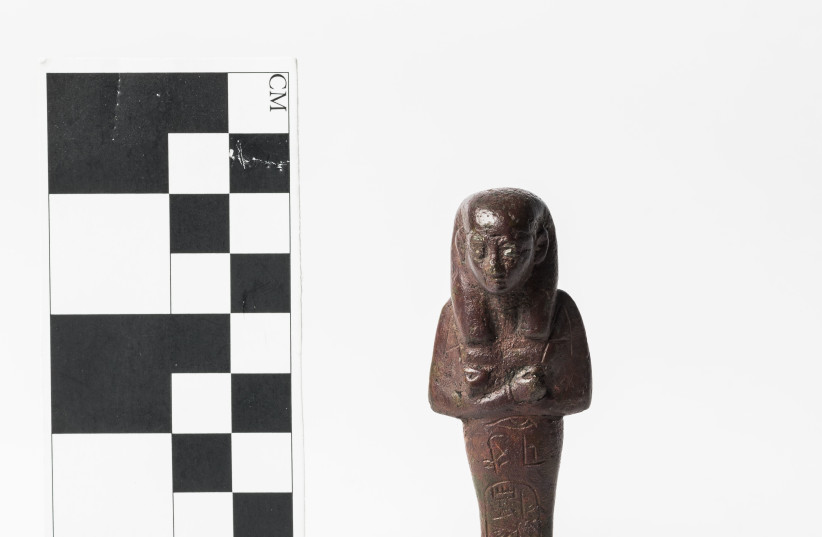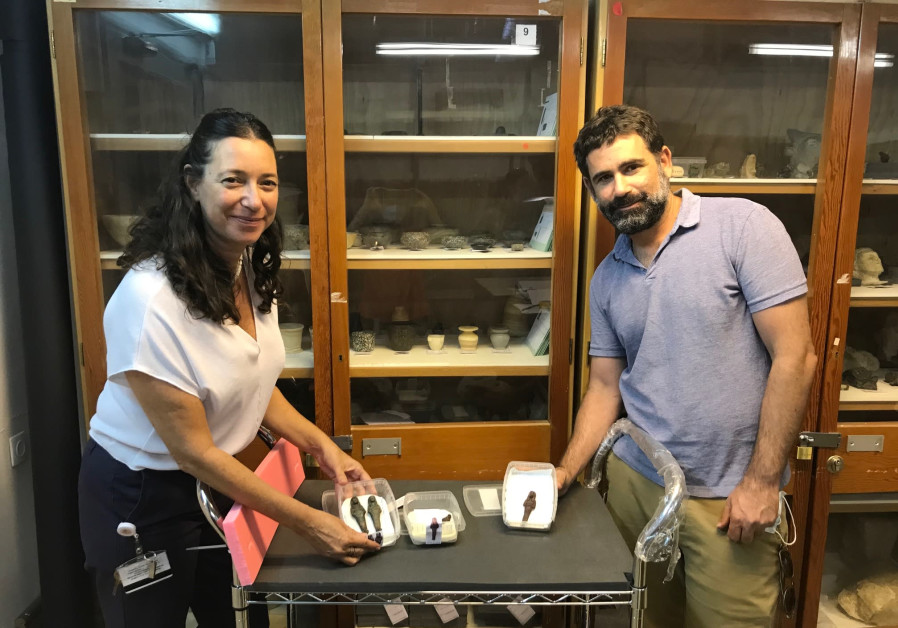 Bronze figurines shed light on Egypt-Israel trade in King David’s time
Bronze figurines shed light on Egypt-Israel trade in King David’s time
ROSSELLA TERCATIN
A new study on some 3,000 years old artifacts proves that Egypt imported copper from the iconic Timna mines.

Did a massive trade route exist some 3,000 years ago between Egypt and Timna, home to the iconic copper mines which have become famous as “King Solomon’s Mines” located in the southern region of modern Israel?
A new innovative study led by Dr. Shirly Ben-Dor Evian, Israel Museum Curator of Egyptian Archaeology and Prof. Erez Ben-Yosef, head of the archaeometallurgical laboratory at Tel Aviv University and director of excavation at Timna, suggests that the answer is yes.
The study analyzed the bronze composition of four 3,000-year-old figurines from the museum’s collection found in the necropolis of Tanis, an Egyptian city in the Delta region that served as the capital of its regional kingdom. The researchers were able to ascertain that the copper used to produce the metal was mined at Timna.
The findings – recently published in the academic journal Journal of Archaeological Science: Reports – shed new light on the relations between Egypt and the populations of the Levant. And according to Ben Yosef, they offer an additional element to support his view that a nomadic kingdom at the time could constitute a wealthy and sophisticated society capable of entertaining complex commercial relations with foreign entities, offering important insights not only on what was happening in Timna – which he believes at the time was part of the biblical Kingdom of Edom – but also in the Jerusalem of King David and King Salomon.
The four artifacts – known as Shabti – are typical funerary figurines that were used in Egypt for millennia.
“In ancient Egypt all subjects were required to devote some time during the year to forced labor for the kingdom,” Ben-Dor Evian said. “Only the members of the elites received a special exemption from the king. However, there was a fear that this exemption would not be granted in the afterlife. For this reason, the members of the upper classes were buried with these figurines, which they thought would act as their servants and work on their behalf.”
The egyptologist noted that sometimes the shabtis in a tomb numbered in hundreds – one for every day of the year, plus some special figurines what would act and supervisors as well as a few extras, in case any of the servant was not able to work. The artifacts often featured elements such as baskets or agricultural tools.
While for several centuries shabtis were manufactured out of several materials, including faience – a primitive form of glass – pottery, and wood, during the Third Intermediate Period (1070–664 BCE) bronze became a very popular material, including for the funerary figurines.
“For decades the prevalence of bronze objects has represented an archaeological mystery because we do not know of any mining site in Egypt at the time,” Ben-Dor Evian said.
For this reason, the researcher had the idea of examining the bronze of a group of artifacts featured in the museum collection. The figurines were chosen because they carried the name of king Psusennes I, his wife and the chief of his army, well known historical figures dating to the second half of the 11th century BCE.
At the time, Egypt was divided and not as powerful as just a few centuries before.
“Yet, we see how it continued to influence the Levant region, as it emerges for example in the iconography of the area, including in some of the seals used by the King of Judah,” Ben-Dor Evian said. “We could describe it as cultural influence. We know that trade can be a powerful source for it.”
The expert contacted Ben Yosef and with a group of PhD students they conducted the lead isotope analysis on the figurines. For all of them, the copper was traced to Timna.
“Before our study, only one other similar study had been conducted, on an individual bronze object in Germany,” Ben Yosef said. “Also in this case, the copper came from Timna.”
While it might still be premature to affirm that the vast amount of copper used in Egypt at the time was all mined at Timna, the fact that five objects analyzed all came back with the same result offers a strong argument to suggest that an important trade route between the two regions existed.
According to Ben Yosef, this development shed further light on the sophistication of the society present at Timna.
The mines at Timna were traditionally associated with King Solomon and the Kingdom of Israel, until an excavation at the end of the 1960s revealed a small Egyptian temple which was brought as evidence that the mining activity was related to Egypt, and dated back to the 13th century BCE some 200 years before King David.
After Ben Yosef began to excavate again in 2013, radio-carbon dating of organic material found proved that the most intense activity of the site happened around 1,000 BCE, the time of David and Solomon, when Egypt was not powerful any more.
While the archaeologist believes that Timna was part of the Edomite Kingdom, which is prominently featured in the Bible, he has also suggested that what was happening at Timna was still very connected to the vicissitudes of contemporary Jerusalem.
Jerusalem could have indirectly controlled the mines – as the biblical text itself suggests when it narrates how David conquered Edom.
Some scholars think that the kingdom of David and Solomon could not have been as powerful as described in the Bible – since the archaeological remains from the time are very scarce. However, according to Ben Yosef, findings at Timna as well as the massive scale of its mining operation without any evidence of prominent buildings offer proof that a rich and powerful territorial entity could have existed without leaving behind such archaeological remains.
Ben-Dor Evian does not believe that at this juncture the cultural affiliation at Timna can be proven, but agrees on the importance of its operations.
For the future, the researchers hope to understand more about the centuries that followed, and especially what happened in terms of the relations between Egypt and the Levant under Sheshonq, who descended to the throne of Tanis around 950 BCE and is known to have launched a military campaign against the Kingdom of Israel, both from archaeological evidence and the biblical text.
“In the fifth year of King Rehoboam, King Shishak of Egypt marched against Jerusalem and carried off the treasures of the House of the LORD and the treasures of the royal palace. He carried off everything; he even carried off all the golden shields that Solomon had made,” reads a passage in the Book of Kings.
How did the war influence the copper trade? A lead isotope analysis of contemporary artifacts might be able to provide answers.
Zawartość publikowanych artykułów i materiałów nie reprezentuje poglądów ani opinii Reunion’68,
ani też webmastera Blogu Reunion’68, chyba ze jest to wyraźnie zaznaczone.
Twoje uwagi, linki, własne artykuły lub wiadomości prześlij na adres:
webmaster@reunion68.com

